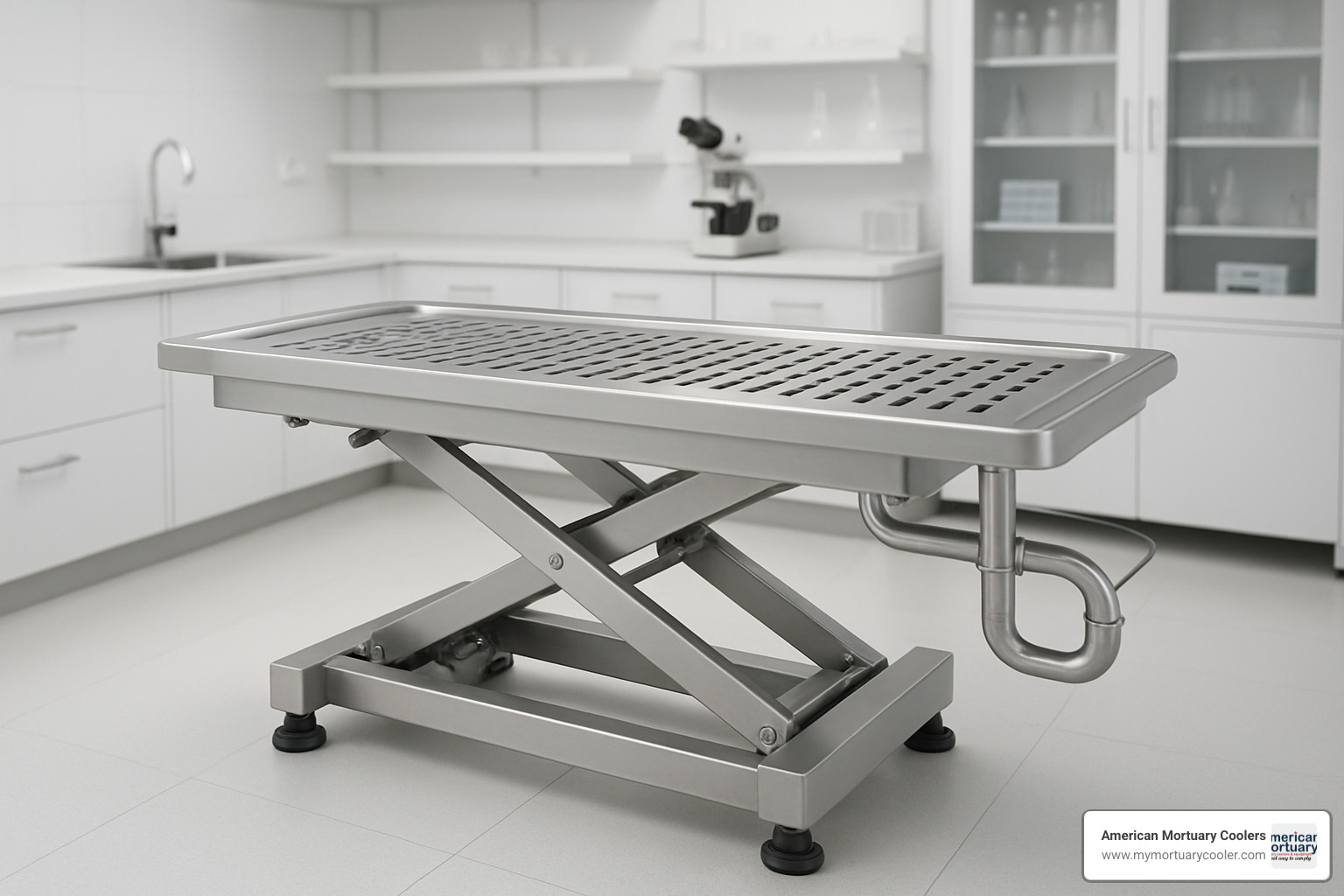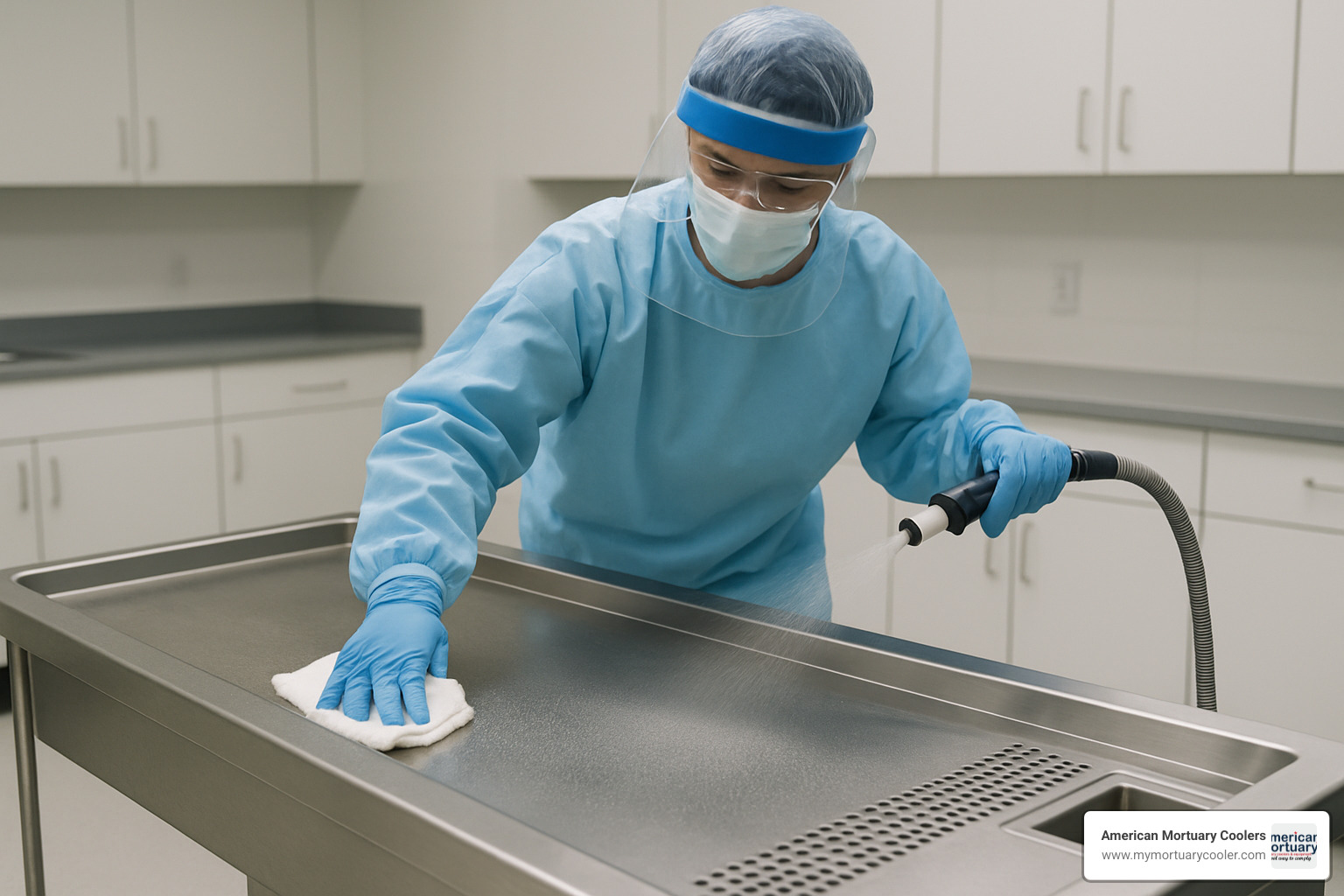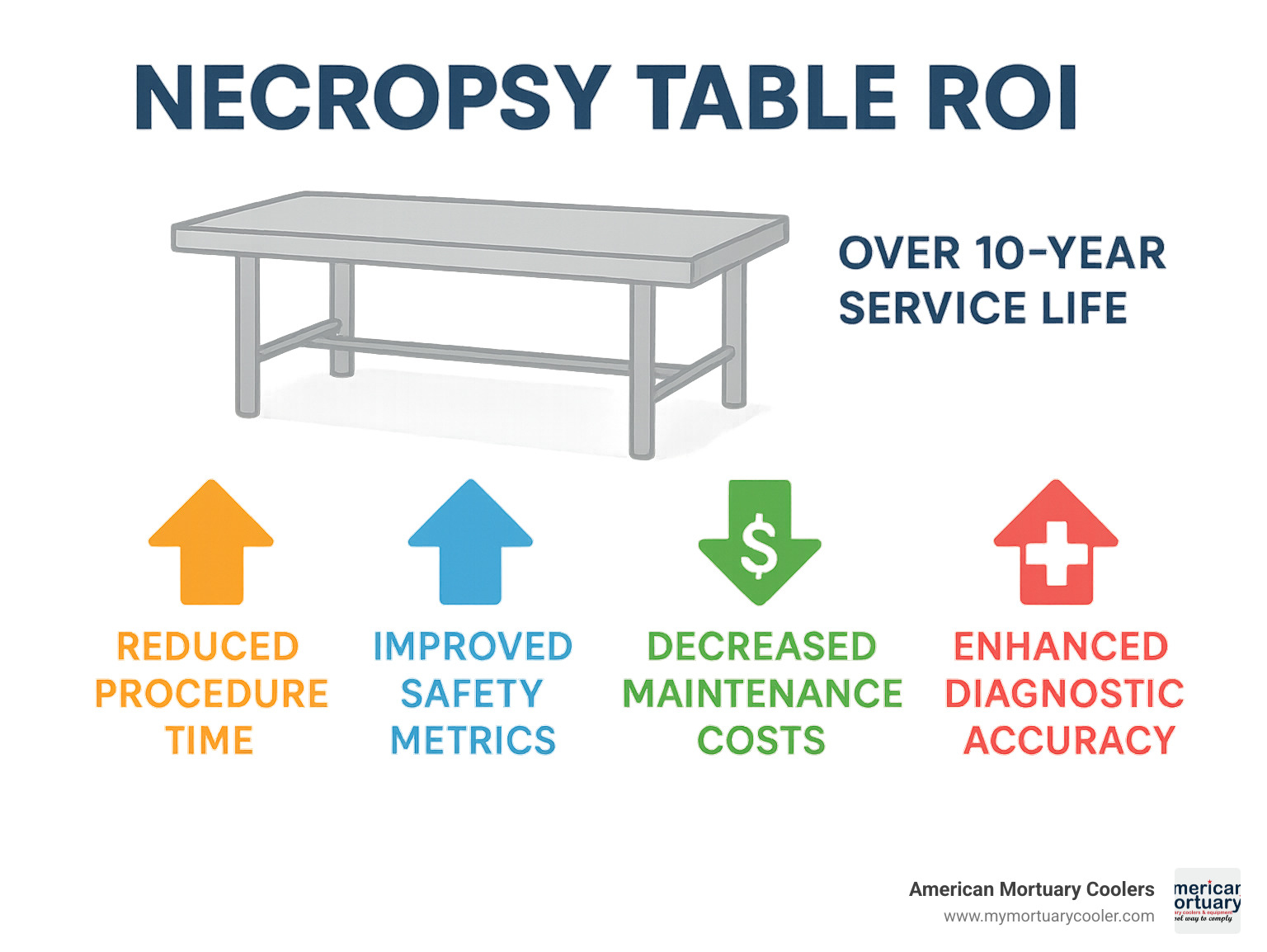
The Ultimate Guide to Choosing a Necropsy Table
Why a Quality Necropsy Table is Critical for Your Laboratory
A necropsy-table- is a specialized workstation designed for animal postmortem examinations in veterinary clinics, research facilities, and diagnostic laboratories. These tables provide a sanitary, ergonomic workspace with integrated drainage, ventilation systems, and safety features essential for efficient necropsy procedures.
Key necropsy table features to consider:
- Materials: Heavy-gauge 304 stainless steel construction for durability and easy cleaning
- Sizes: Standard dimensions range from 36″ × 84″ to 48″ × 108″ to accommodate different animal sizes
- Load capacity: Modern tables handle up to 5,000 lbs centralized load and 2,500 lbs offset load
- Drainage: Sloped surfaces with integrated drains and perforated panels for fluid management
- Ventilation: Optional downdraft systems to control fumes and maintain OSHA exposure limits
- Mobility: Lockable 5-inch casters for repositioning and stability during procedures
The right necropsy table directly impacts workflow efficiency, staff safety, and diagnostic accuracy. Poor table design can lead to contamination risks, ergonomic strain, and compromised sample quality.
As research shows, necropsy remains "the most efficient and cost-effective investigative technique" for determining cause of death and disease processes. However, this critical diagnostic tool requires proper equipment to deliver reliable results.
About the Author: I'm Mortuary Cooler, a national-level mortuary cooler supplier with extensive experience helping laboratories select the right necropsy-table- solutions for their specific needs.

Necropsy-table- terms to remember:
Necropsy-table- Fundamentals: Function, Materials & Workflow
A necropsy-table- serves as the command center of your laboratory, creating a workspace that handles everything from tiny research specimens to large animals with equal precision.
The heart of any necropsy operation requires more than just a flat surface. Your table needs to be a complete system supporting every step of the examination process. Veterinary labs and research facilities depend on these workstations to maintain the highest standards while dealing with specimens ranging from laboratory mice to farm animals weighing hundreds of pounds.
These tables are designed around workflow efficiency. Every slope, drain, and surface angle serves a purpose. The drainage slope prevents fluid buildup that could compromise samples or create contamination risks. When fluids flow smoothly toward collection points, your entire process becomes cleaner and more reliable.
Load capacity matters significantly. Modern necropsy tables handle up to 5,000 pounds of centralized weight and 2,500 pounds offset. This robust construction means you're investing in equipment that won't wobble, shift, or fail when you need it most.
The primary function extends beyond simple specimen support. These tables integrate sample collection systems, drainage management, and accessory mounting points that keep essential tools within arm's reach. Autolysis control depends partly on how quickly and efficiently you can work, which proper table design directly supports.
Why Stainless Steel Rules the Lab
For necropsy tables, 304 stainless steel isn't just preferred - it's practically the only sensible option.
Material strength forms the foundation. Heavy-gauge stainless steel construction (typically 14 to 16-gauge thickness) creates a workspace that maintains integrity through years of demanding use.
Sanitation becomes effortless with the right material. The non-porous surface means bacteria can't hide in cracks or crevices. When you need to disinfect between procedures, a quick wipe-down with appropriate cleaning agents leaves your surface truly clean.
Longevity makes the investment worthwhile. While stainless steel costs more upfront, your table will still perform flawlessly after decades of daily use, while cheaper alternatives require multiple replacements.
Corrosion resistance proves its worth daily. Necropsy work exposes equipment to biological fluids, formalin, alcohol, and aggressive cleaning chemicals. The chromium in 304 stainless steel forms a protective layer that self-repairs when scratched, maintaining corrosion resistance throughout the table's lifespan.
The heliarc-welded seams, ground smooth and polished, eliminate hiding spots where contaminants might lurk. Combined with radiused corners, this seamless construction makes thorough cleaning genuinely easy.
Necropsy-table- Types and Designs Compared
Choosing the right necropsy-table- design becomes straightforward when you understand how each type serves specific needs.
Standard necropsy tables form the backbone of most veterinary facilities. These workhorses feature fixed heights and straightforward designs in 36″ × 84″ to 48″ × 108″ sizes, handling everything from cats to large dogs. Their simplicity means fewer moving parts, less maintenance, and more reliable performance.
Downdraft systems improve safety by pulling dangerous fumes away from your breathing zone. These tables incorporate ventilation that draws air downward through the work surface, capturing vapors before they reach you. While they cost more upfront, the health benefits make them invaluable for facilities handling high volumes or hazardous materials.
Mobile units offer flexibility with heavy-duty 5-inch casters and reliable locking mechanisms. These tables adapt to changing needs without compromising stability or safety.
Hydraulic lift systems address back strain from awkward working heights. These systems let you adjust table height for comfort. Battery-powered hydraulic systems work independently of electrical outlets, providing true positioning freedom.
Large-animal platforms handle cases that standard tables can't accommodate. These reinforced units include tie-down bars for specimen security and improved drainage systems for increased fluid volumes.
Small-rodent stations optimize efficiency for high-volume laboratory animal work, providing dedicated workspace scaled for mice and rats while maintaining rigorous safety standards.
Perforated panels appear across all table types as removable components. Most tables include five 14-gauge perforated panels that you can remove individually for washing or replacement.
| Feature | Standard Table | Downdraft Table |
|---|---|---|
| Ventilation | None | Built-in downdraft system |
| Safety | Basic PPE required | Improved fume protection |
| Cost | Lower initial investment | Higher upfront cost |
| Maintenance | Minimal | Regular filter/system service |
| Applications | General necropsy | High-risk procedures |
Necropsy-table- Downdraft Models: Safety First
Downdraft systems represent the gold standard in laboratory safety, providing essential protection against chemicals that can cause serious health problems.
OSHA compliance drives many facilities toward downdraft systems. Regulations require that exposure to chemicals like formalin, alcohol, and xylene stays below specific limits. Traditional room ventilation often fails to protect you at your breathing zone during detailed examinations.
Fume capture effectiveness comes from creating negative pressure that pulls contaminated air away from your face through filtration systems. This works far better than overhead ventilation, which can create air turbulence that increases exposure.
Scientific research on downdraft ventilation shows that well-designed systems can reduce breathing zone concentrations by 80-90% compared to conventional ventilation.
Mobile necropsy-table- Solutions for Flexible Labs
Mobile necropsy tables deliver flexibility without sacrificing functionality.
Heavy-duty casters make the difference between smooth movement and wrestling matches. Quality mobile tables feature 5-inch diameter casters rated for maximum load capacity plus safety margins.
Dual-brake locking mechanisms provide stability during procedures by locking both wheel rotation and swivel action. Brake engagement should be easily accessible but secure against accidental release.
Hydraulic scissor lift systems offer 12-18 inches of height adjustment without compromising structural integrity. Battery power eliminates the hassle of finding electrical outlets, with 24V battery systems providing sufficient power for multiple adjustments per charge.
Core Features, Safety & Ergonomics
When selecting a necropsy-table-, the difference between good and great lies in how well it integrates safety features, ergonomic design, and practical functionality.
Drainage and plumbing systems feature carefully engineered slopes (typically 1 inch toward the drain) ensuring fluids move away from your work area. Ball-valve fluid controls give you complete control over drainage timing.
Perforated plates are precision-engineered 14-gauge stainless steel components with strategically sized perforations. Their removability allows thorough cleaning between procedures or replacement when they show wear.
For larger specimens, tie-down bars provide rock-solid security for restraint systems, integrating seamlessly into the table design.
Accessory sockets at each corner transform your basic table into a customizable workstation. These standardized connection points accommodate instrument trays, documentation stands, and other equipment.
Integrated scales eliminate the awkward process of moving specimens to separate weighing equipment, providing crucial weight measurements for dosing calculations and research protocols.
LED task lighting systems offer excellent color rendering while generating minimal heat. Adjustable positioning eliminates shadows that might hide important findings.
GFCI outlets provide convenient power access for cameras, scales, and electronic equipment while protecting against electrical hazards in wet laboratory environments.
The ergonomic height range with 6-12 inches of adjustment accommodates operators of different heights. Proper working height impacts procedure accuracy and reduces fatigue-related errors.

Splash guards protect both you and surrounding work areas from unexpected fluid splashing, available as permanent fixtures or removable components.
Those load ratings of 5,000 lbs centralized and 2,500 lbs offset represent substantial safety margins for virtually any necropsy application, accounting for dynamic loading conditions.
Downdraft Ventilation: Built-in Fume Protection
Downdraft ventilation creates sophisticated, controlled airflow patterns that capture contaminants at their source.
Airflow metrics typically provide 100-150 feet per minute face velocity across the work surface - the optimal range for capturing laboratory chemicals before they reach your breathing zone.
Internal baffle design distributes airflow uniformly across the entire table length while maintaining energy efficiency. Without proper baffles, airflow becomes uneven, creating dead spots where fumes accumulate.
Formalin vapor control represents one of the most important applications. A well-designed downdraft system captures these vapors before they reach dangerous concentrations, creating a protective bubble around your work area.
Operator safety improvements extend beyond chemical exposure reduction. Controlled airflow helps manage biological aerosols containing infectious agents, providing additional protection during necropsy procedures.
More info about autopsy table design provides insights into how ventilation systems integrate with overall table design.
Selecting, Installing & Maintaining Your Table
Choosing the perfect necropsy-table- becomes manageable when broken into clear steps.
Space assessment should be your starting point. You need room not just for the table, but for people to move around it comfortably. Don't forget doorways - ensure your perfect table will actually fit through your entrance.
Animal size matching is crucial for maximizing your investment. 36″ × 84″ tables work well for small animals, while 48″ × 96″ or 48″ × 108″ dimensions provide extra room for larger specimens.
Standard dimensions include 36″ × 84″, 36″ × 96″, 48″ × 84″, 48″ × 96″, and 48″ × 108″ configurations that fit through standard doorways.
Workflow integration requires thinking about how your table connects with specimen storage, sample prep areas, and documentation stations.
Sink and spray hose hookups need adequate water pressure and drainage capacity. Most tables include flexible spray hoses that stretch about 10 feet with hot and cold water mixing capability.
Electrical requirements vary by features. Basic tables might only need GFCI outlets, while hydraulic models require dedicated circuits. Downdraft systems may need three-phase power for larger units.
Budgeting should include installation costs, training time, and ongoing maintenance. Quality necropsy tables are investments that pay off over decades of reliable service.
Customization options let you create exactly what your lab needs. At American Mortuary Coolers, we work with customers to design custom solutions fitting exact specifications while maintaining quality standards.
Preventative maintenance keeps your table running smoothly through regular cleaning, lubrication of moving parts, drainage system inspections, and safety feature testing.
Disinfectants must be effective against pathogens while compatible with stainless steel. Quaternary ammonium compounds, phenolic compounds, and bleach solutions work well when used properly.
Daily wash-down procedures should include removing organic material, applying disinfectant, waiting for required contact time, then rinsing thoroughly.

Biosafety protocols address unique risks from infectious agents, toxic chemicals, and biological hazards, specifying PPE requirements, waste disposal procedures, and emergency response plans.
Customization Checklist
Height presets for hydraulic lift tables can be programmed for different operators or procedure types, eliminating guesswork and ensuring consistent working heights.
Accessory holders integrate seamlessly to support commonly used equipment including instrument trays, camera mounts, and documentation stands.
Integrated sinks provide convenient hand washing and instrument cleaning without leaving your work area.
Digital documentation ports bring tables into the modern age with power outlets, network connections, and mounting hardware for cameras, tablets, and computer workstations.
More info about folding tables provides insights into specialized configurations for labs with unique requirements.
Storage solutions built into table bases provide convenient access to frequently used supplies while maintaining structural integrity and cleaning accessibility.
Frequently Asked Questions about necropsy-table-
What load capacity should I look for?
Choosing the right load capacity for your necropsy-table- isn't just about the biggest animal you'll examine - it's about building in safety margins that protect both your staff and equipment. I've seen too many labs underestimate their needs and regret it later.
For small animal practices focusing on dogs, cats, and laboratory animals, you might think a 1,000-2,000 lb capacity sounds reasonable. But here's the thing - you're not just supporting the specimen weight. Add in the weight of equipment, the pressure from operators leaning on the table during procedures, and the dynamic forces from repositioning specimens, and suddenly that "adequate" capacity doesn't feel so comfortable.
Our recommendation? Go with tables rated for 5,000 lb centralized load capacity and 2,500 lb offset load capacity, even if you primarily work with smaller animals. This isn't overkill - it's smart planning. These higher ratings indicate more robust construction that translates to better stability during delicate procedures and longer service life overall.
Think of it as buying a truck. You don't buy one that can barely haul your current load - you get one with capacity to spare. The same logic applies to necropsy tables, where safety and reliability can't be compromised.
How often should a necropsy table be disinfected?
The short answer? After every single procedure. No exceptions, no shortcuts. Cross-contamination in necropsy work isn't just a cleanliness issue - it can completely compromise diagnostic results and create serious biosafety risks.
Your standard disinfection routine should include removing all organic material first (you can't disinfect through debris), applying the appropriate disinfectant, and allowing proper contact time. Most disinfectants need 5-10 minutes of contact time to be effective, though this varies by product and pathogen risk level.
For high-risk cases involving known infectious agents, step up your game. Use stronger disinfectants, extend contact times, and consider additional precautions based on your facility's biosafety protocols. When in doubt, err on the side of caution.
Don't forget about daily deep cleaning beyond the between-procedure disinfection. This includes thorough attention to drainage systems, accessory components, and those hard-to-reach areas where residues can accumulate. Weekly or monthly maintenance cleaning helps ensure your necropsy-table- maintains optimal sanitation standards throughout its service life.
Do I need a downdraft system for small animal work?
This question comes up constantly, and my answer usually surprises people: Yes, you probably do - even for routine small animal procedures. Let me explain why.
If you're using formalin, alcohol preservatives, or other volatile chemicals regularly, downdraft systems aren't a luxury - they're essential for OSHA compliance and operator health protection. Even brief exposures to these chemicals can cause respiratory irritation, and the long-term health effects of repeated exposure aren't worth the risk.
High-volume facilities especially benefit from downdraft protection. When you're performing multiple procedures daily or extended examinations, those chemical exposures add up quickly. The system also protects against biological aerosols that might contain infectious agents - an extra safety layer that's particularly valuable when working with specimens of unknown disease status.
Here's something many people don't consider: downdraft systems might be required by your institutional safety policies, insurance, or regulatory standards. Even if they're not mandatory now, regulations tend to get stricter over time, not more relaxed.
Installing downdraft capability during your initial necropsy-table- selection provides future flexibility and shows you're serious about operator safety. Your staff will thank you, and you'll have peace of mind knowing you've invested in the best protection available.
Conclusion & Next Steps
Choosing the right necropsy-table- isn't just about buying equipment - it's about investing in your laboratory's future success. The right table transforms your necropsy workflow, protects your staff, and improves diagnostic accuracy for years to come.
The foundation starts with 304 stainless steel construction that withstands daily chemical exposure and thorough cleaning protocols. Your table needs to match specimen size requirements, provide adequate load capacity with safety margins, and integrate seamlessly with existing laboratory workflow.
Safety features like downdraft ventilation systems aren't luxury add-ons - they're essential investments in your team's long-term health. Whether handling formalin fixatives, unknown pathogens, or maintaining OSHA compliance, proper ventilation protects what matters most: your people.
At American Mortuary Coolers, we've helped laboratories nationwide find their perfect necropsy solution. From small veterinary clinics to major research facilities, we've learned that custom solutions often provide the best value.

Before making your final decision, assess your current and future specimen requirements. Planning ahead saves money and headaches down the road.
Evaluate your facility's infrastructure capabilities. The most advanced hydraulic lift system won't help if your electrical service can't support it. Similarly, downdraft systems require adequate exhaust capacity to function properly.
Workflow integration deserves serious consideration. Your new table should improve efficiency, not create bottlenecks.
The long-term ROI of quality necropsy equipment extends beyond purchase price. Well-designed tables reduce procedure times, minimize repetitive strain injuries, and improve diagnostic accuracy - benefits that compound over decades of service life.
Budget planning should include installation, training, and ongoing maintenance. Quality equipment costs more upfront but delivers better value through reliable performance and lower maintenance requirements.
We specialize in custom fabrication that meets your exact specifications while maintaining durability standards that have made us a trusted supplier nationwide.
Ready to explore your options? More info about mortuary cooler solutions awaits at our website, where you can learn more about our full range of laboratory equipment and custom capabilities.
Contact us today to discuss your necropsy-table- requirements. Our team delivers custom solutions across all 48 contiguous states, and we're excited to help you create the perfect necropsy workspace for your laboratory's success.



